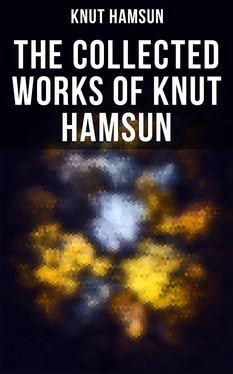In America, where he landed penniless, he turned his strong and capable hands to whatever labour he could find. He had intended to become a Unitarian minister. Instead of doing so he had to work as a farm-hand on the prairie, street-car conductor in Chicago, dairyman in Dakota; and he varied these pursuits by giving a series of lectures on French literature in Minneapolis. By that time he probably imagined that he was equipped for a more successful attack on the literary strongholds of his own country, and returned to Christiania. Disappointments and privations followed more bitter than any he had ever known. He starved and studied and dreamed; vainly he made the most desperate attempts to gain recognition. In despair he once more abandoned the battle-field and fled to America again, with the avowed purpose of gaining a reputation on the lecture platform.
Once more he failed; his countrymen resident in the Northwest would have none of him. Beaten back in every attempt, discouraged, perhaps feeling the need of solitude and the opportunities for introspective thought which he could not find in the larger cities, he exiled himself to that most desolate of existences, a life on a Newfoundland fishing-smack. Three long years he spent as one of a rude crew with whom he could have nothing in common save the daily death-struggle with the elements. But these years finished the preparatory stage of Hamsun's education. During the solitary watches he matured as an artist and as a man. In his very first effort upon his return to civilisation he proved that the days of aimless fumblings were over: in "Hunger" he stands suddenly revealed as a master of style and description, a bold and independent thinker, a penetrating, keen psychologist, a realist of marked virility.
Since "Hunger" was written Hamsun has published over thirty large works— novels, dramas, travel descriptions, essays, and poems. Every one of them is of a high order. Each is unlike the rest; but through them all flash in vivid gleams a dazzling witchery of style, a bewildering originality, a passionate nature-worship, and an imagination which at times takes away the breath.
"Shallow Soil," in some respects the most contained of Hamsun's works, is perhaps best suited as a medium for his introduction to Anglo-Saxon readers. In a very complete analysis of Hamsun's authorship the German literary critic, Professor Carl Morburger, thus refers to "Shallow Soil":
"Not only is this book Knut Hamsun's most significant work, but it gives the very best description available of life in Christiania toward the close of the century. A book of exquisite lyric beauty, of masterly psychology, and finished artistic form, it is so rich in idea and life that one must refrain from touching on the contents in order to keep within the narrow limits of this essay. A most superbly delicate delineation of the feminine soul is here given in the drawing of Hanka and Aagot; nowhere else is woman's love in its dawn and growth described with such mastery, with a deftness and sureness of touch which reminds one of the very greatest passages in that Danish classic, 'Niels Lyhne.'"
Hamsun is now in his fifty-fourth year. The expectations aroused by his first book have been more than fulfilled; the star that was born overnight still shines with undimmed brilliance—nay, with a purer, warmer, steadier flame. The volcanic violence of earlier days has been mellowed and subdued; the "red eruptions of flame-tongued, primeval power" have all but ceased. In one of his latest works Hamsun himself notes this change in saying: "When a wanderer reaches fifty years he plays with muted strings." But with or without the sordine Hamsun's production is equally seductive, equally entrancing and compelling. All over the continent of Europe he is known and his writings treasured; in Russia his popularity exceeds that of many of its own inimitable writers. It is to be expected that the English-speaking world will accord him that appreciation which is the natural tribute to genius, irrespective of language or clime.
CARL CHR. HYLLESTED.
NEW YORK, December, 1913.
Table of Contents
A faint, golden, metallic rim appears in the east where the sun is rising. The city is beginning to stir; already can be heard an occasional distant rumble of trucks rolling into the streets from the country, large farm-wagons heavily loaded with supplies for the markets—with hay and meat and cordwood. And these wagons make more noise than usual because the pavements are still brittle from nightly frosts. It is the latter part of March.
Everything is quiet around the harbour. Here and there a sleepy sailor tumbles out of a forecastle; smoke is curling from the galleys. A skipper puts his head out of a companionway and sniffs toward the weather; the sea stretches in undisturbed calm; all the winches are at rest.
The first wharf gate is thrown open. Through it one catches a glimpse of sacks and cases piled high, of cans and barrels; men with ropes and wheelbarrows are moving around, still half asleep, yawning openly with angular, bearded jaws. And barges are warped in alongside the docks; another army begins the hoisting and stowing of goods, the loading of wagons, and the moving of freight.
In the streets one door after another is opened; blinds are raised, office-boys are sweeping floors and dusting counters. In the H. Henriksen office the son is sitting at a desk, all alone; he is sorting mail. A young gentleman is strolling, tired and sleepy, toward the railway square; he comes from a late party given in some comrade's den and is taking the morning air. At Fire Headquarters he runs across an acquaintance who has also been celebrating.
"Abroad so early, Ojen?" asks the first stroller.
"Yes—that is to say, I haven't been in bed yet!"
"Neither have I," laughs the first. "Good night!"
And he wanders on, smiling in amusement over that good night on a bright and sunny morning. He is a young and promising man; his name had suddenly become famous two years ago when he published a lyric drama. His name is Irgens; everybody knows him. He wears patent-leather shoes and is good-looking, with his curled moustache and his sleek, dark hair.
He drifts from one market square to another; it amuses him, sleepy as he is, to watch the farmers who are invading the public squares with their trucks. The spring sun has browned their faces; they wear heavy mufflers around their necks, and their hands are sinewy and dirty. They are in such a hurry to sell their wares that they even hail him, a youth of twenty-four without a family, a lyric writer who is simply loitering at random in order to divert himself.
The sun climbs higher. Now people begin to swarm in all directions; shrill whistles are heard, now from the factories in the city suburbs, now from the railway stations and docks; the traffic increases. Busy workers dart hither and thither—some munching their breakfast from newspaper parcels. A man pushes an enormous load of bundles on a push-cart, he is delivering groceries; he strains like a horse and reads addresses from a note-book as he hurries along. A child is distributing morning papers; she is a little girl who has Saint Vitus's dance; she jerks her angular body in all directions, twitches her shoulders, blinks, hustles from door to door, climbs the stairs in the high-storied houses, presses bells, and hurries on, leaving papers on every doorstep. A dog follows her and makes every trip with her.
Traffic and noise increase and spread; beginning at the factories, the wharves, the shipyards, and the sawmills, they mingle with wagon rumblings and human voices; the air is rent by steam-whistles whose agonising wails rise skyward, meeting and blending above the large squares in a booming diapason, a deep-throated, throbbing roar that enwraps the entire city. Telegraph messengers dart hither and yon, scattering orders and quotations from distant markets. The powerful, vitalising chant of commerce booms through the air; the wheat in India, the coffee in Java promise well; the Spanish markets are crying for fish—enormous quantities of fish during Lent.
Читать дальше












